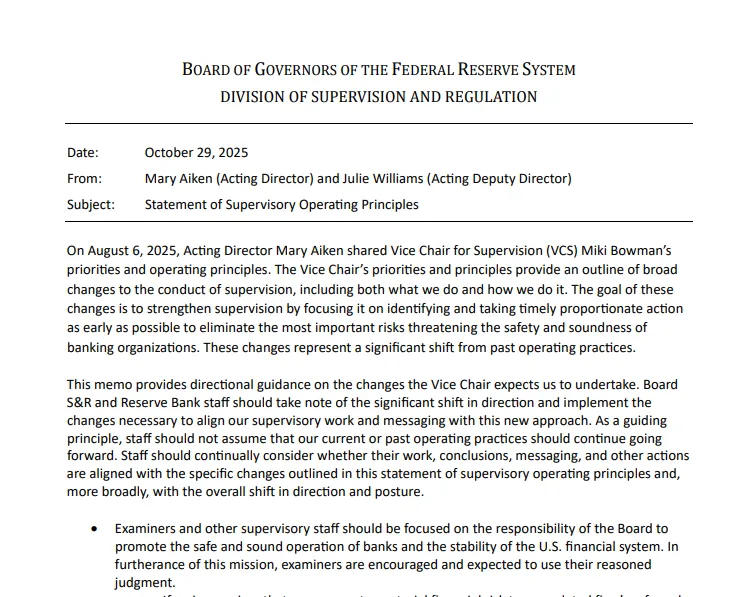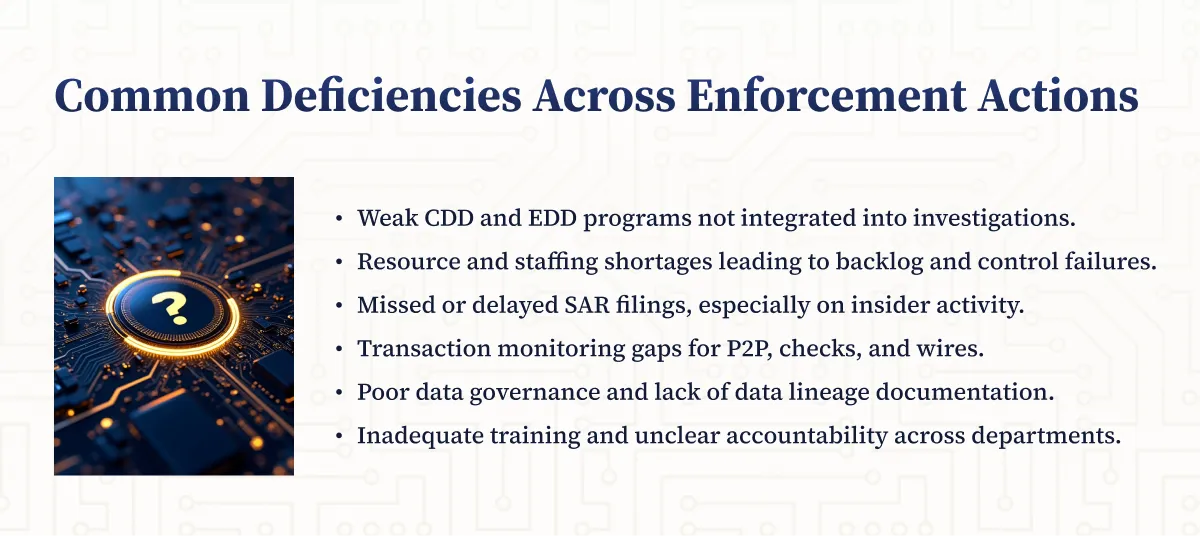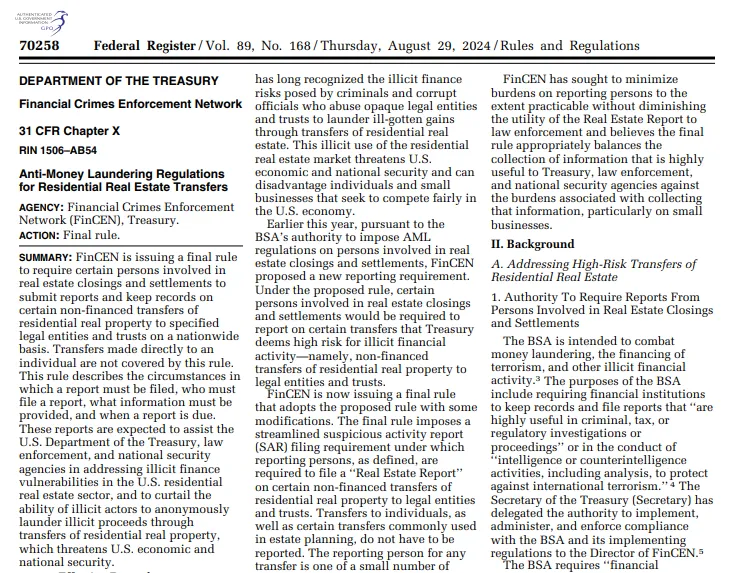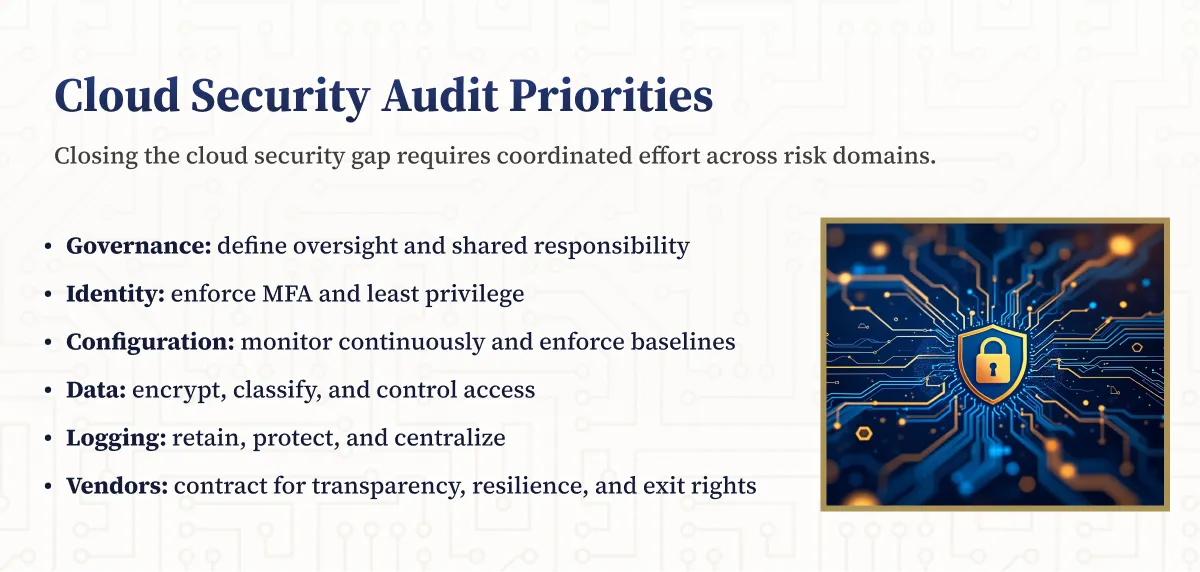In October 2025, the Federal Reserve Board released a pivotal Statement of Supervisory Operating Principles, signaling a significant shift in the approach to bank supervision. This new direction, championed by Vice Chair for Supervision Miki Bowman, aims to enhance the effectiveness and efficiency of supervision by focusing on timely, proportionate action against material risks to the safety and soundness of banking organizations. For compliance professionals at financial institutions, understanding these changes is essential for aligning internal practices with regulatory expectations and preparing for future examinations.
NETBankAudit experts have over 25 years of experience in regulatory compliance audits. If you have any questions after reading this guide, please reach out to our team.
Key Shifts in Supervisory Focus and Methodology
Prioritizing Material Financial Risks Over Process and Documentation
The Federal Reserve’s new principles direct examiners to concentrate their attention on a firm’s material financial risks, rather than being sidetracked by non-critical processes, procedures, or documentation. This approach is designed to ensure that supervisory resources are allocated to the most significant threats to a bank’s safety and soundness.
- Examiners are expected to use reasoned judgment and escalate issues that present material financial risks but are not adequately addressed by existing supervisory tools.
- Shortcomings that do not rise to the level of Matters Requiring Attention (MRAs) or Matters Requiring Immediate Attention (MRIAs) can be addressed through nonbinding supervisory observations, reversing the previous directive to eliminate such observations.
- This shift allows for more effective supervision by enabling staff to focus on what truly matters for institutional stability.
Reliance on Primary Supervisors and Internal Audit Functions
A major change in the supervisory approach is the increased reliance on the work of primary state or federal banking supervisors and internal audit functions, especially for bank holding companies and their subsidiaries. The Federal Reserve will only conduct its own examinations if it is impossible to rely on the primary supervisor’s work, such as when information sharing is insufficient.
- For state member banks, joint examinations with state agencies are encouraged, and reliance on state agency findings is prioritized, particularly for institutions eligible for alternate-year examination programs.
- When validating remediation of MRAs, MRIAs, or enforcement actions, examiners should depend on a firm’s internal audit if it is rated satisfactory, avoiding duplicative validations unless the internal audit is unsatisfactory.
- Termination of MRAs or enforcement actions should not be delayed to test sustainability; instead, ongoing monitoring will ensure continued compliance.
Implications for Bank Compliance Programs
Streamlining Documentation and Process Requirements
Compliance teams should expect less regulatory emphasis on exhaustive documentation and procedural minutiae that do not pose material risks. This means institutions can focus their compliance resources on areas that have a direct impact on financial stability, rather than on box-checking exercises.
- Supervisory observations will be used for minor issues, reducing the burden of formal remediation for non-material deficiencies.
- Institutions should still maintain robust documentation for material risk areas, as these will remain a primary focus of examinations.
Enhanced Dialogue and Clarity in Supervisory Communications
The Federal Reserve is mandating that MRAs and MRIAs be communicated with clear, specific language. This is intended to foster meaningful dialogue between examiners and bank representatives, ensuring that expectations are well understood and remediation paths are clear.
- Examiners must provide enough detail so that a person of ordinary intelligence can understand the deficiency and what constitutes a non-deficient state.
- Banks are encouraged to seek clarification and provide feedback if an MRA or MRIA is unclear or unjustified.
- Prompt responses from examiners to institutional questions are now an explicit expectation.
Changes to Supervisory Ratings and Enforcement Actions
Balanced Weighting of CAMELS and RFI/C (D) Components
Supervisory ratings will now more accurately reflect an institution’s financial condition and material risks. The management and risk management components of CAMELS and RFI/C (D) ratings will no longer be given disproportionate weight in determining composite ratings.
- All rating components will be considered and weighed based on their materiality to the institution.
- This change aims to provide a more accurate and fair assessment of a bank’s overall health.
Refined Standards for MRAs, MRIAs, and Enforcement Actions
The criteria for issuing MRAs and MRIAs are being updated to prioritize deficiencies that could materially impact a firm’s financial condition, rather than focusing on procedural or documentation shortcomings. Additionally, the standard for enforcement actions based on unsafe or unsound practices is under review, with further guidance forthcoming.
- MRAs and MRIAs must be specific, actionable, and tied to material risks.
- Enforcement actions will be more closely aligned with actual threats to safety and soundness, rather than technical or procedural violations.
Tailored Supervision Based on Size, Complexity, and Systemic Importance
Resource Allocation and Horizontal Reviews
The Federal Reserve is directing staff to tailor supervision based on the size, complexity, and systemic importance of each banking organization. Larger, more complex, and systemically important institutions will receive more supervisory attention, while smaller, less complex organizations will see a lighter touch.
- Horizontal reviews in the Large Institution Supervision Coordinating Committee (LISCC) and Large and Foreign Banking Organization (LFBO) portfolios will only be conducted if the benefits outweigh the costs, as determined by the Deputy Director of Supervision.
- Assessments from horizontal reviews will be measured against supervisory expectations, not best practices within peer groups, and results will be confidentially disclosed to the banks involved.
Liquidity Management and Federal Home Loan Banks
Supervisory staff are now explicitly instructed not to discourage or prohibit banks from considering liquidity available from the Federal Home Loan Banks (FHLBs) in their liquidity management or stress testing. Additionally, prepositioning assets at the discount window is no longer a required condition for future secured borrowings.
- This change provides banks with greater flexibility in managing liquidity and responding to stress scenarios.
- It also aligns supervisory expectations with the practical realities of liquidity management in the current financial environment.
Action Steps for Compliance Professionals
Aligning Internal Audit and Remediation Processes
Given the increased reliance on internal audit functions for validating remediation, compliance professionals should ensure that their internal audit programs are robust, well-documented, and capable of providing credible assurance to regulators. A satisfactory internal audit rating will streamline the remediation and termination of MRAs and enforcement actions.
- Review and enhance internal audit methodologies to ensure they meet regulatory expectations for independence, rigor, and documentation.
- Establish clear protocols for tracking and reporting on remediation efforts, with a focus on material risk areas.
Preparing for More Focused and Efficient Examinations
With the Federal Reserve’s renewed focus on material risks, compliance teams should proactively identify and address the most significant threats to their institution’s safety and soundness. This includes conducting regular risk assessments, updating risk management frameworks, and ensuring that controls are effective in mitigating key risks.
- Conduct gap analyses to identify areas where current practices may not align with the new supervisory principles.
- Engage with examiners early and often to clarify expectations and address potential issues before they escalate.
Looking Ahead: The Future of Federal Reserve Supervision
Ongoing Evolution and Industry Impact
The Federal Reserve’s 2025 Statement of Supervisory Operating Principles marks a significant evolution in the regulatory landscape. By prioritizing material risks, streamlining processes, and fostering clearer communication, the new approach is designed to make supervision more effective and less burdensome for well-managed institutions. Compliance professionals should stay informed about further guidance and be prepared to adapt as the Federal Reserve continues to refine its supervisory framework.
- Monitor regulatory updates and participate in industry forums to stay ahead of emerging expectations.
- Invest in training and development for compliance staff to ensure readiness for the new supervisory environment.
Partner with NETBankAudit for Regulatory Readiness
Navigating the evolving landscape of Federal Reserve supervision requires expertise, agility, and a proactive approach to compliance. NETBankAudit offers specialized audit and consulting services tailored to the needs of financial institutions facing regulatory change. Our team brings over 25 years of experience in risk management, internal audit, and regulatory compliance, helping banks and credit unions align with the latest supervisory expectations while optimizing operational efficiency.
Whether you need support with internal audit readiness, risk assessment, or regulatory exam preparation, NETBankAudit delivers actionable insights and practical solutions. Contact us today to learn how we can help your institution thrive under the Federal Reserve’s new supervisory principles.
%201%20(1).svg)
%201.svg)
.avif)

.svg)




.webp)
.png)




.webp)

.webp)











.webp)



.webp)

%201.webp)
.webp)
%20(3).webp)


.webp)


%20Works.webp)


.webp)




.webp)
%20(1).webp)

.webp)










.webp)
.webp)

.webp)
.webp)
.webp)
.webp)
.webp)
.webp)
%201.svg)